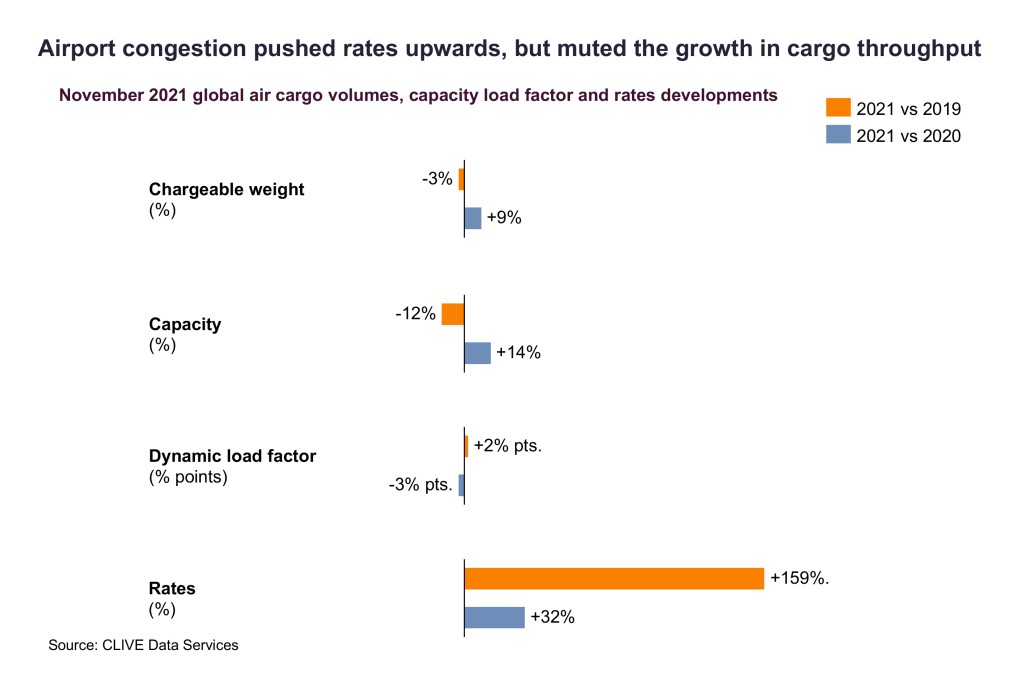Congestion on the ground muted air cargo growth in November
Dec 01, 2021Congestion on the ground muted air cargo’s growth in November, with volumes falling by -1.2% versus October, reversing the trend traditionally seen in the peak build-up to Christmas, according to the latest global air cargo market intelligence from industry analysts, CLIVE Data Services.
CLIVE’s analyses of the air cargo market for the full four weeks of November 2021 measures the industry’s performance to the pre-covid 2019 level, as well as providing 2020 year-over-year comparisons, to produce a meaningful assessment of the current operating performance. Last month’s fall in volumes compared to October 2021 came despite a +0.5% rise in capacity, while overall air cargo rates climbed +8% in November month-on-month.

Compared to November 2019, last month recorded a 3% decline in demand, but overall air cargo rates remained buoyant at +159%. Capacity versus two years ago was -12%, lifting CLIVE’s ‘dynamic load factor’ – based on both the volume and weight perspectives of cargo flown and capacity available to produce a true indicator of airline performance – up 2% pts to 66%.
Europe to North America market data for the last week of October versus the third week of November, prior to the Thanksgiving holiday in the US, showed capacity down 7.3% and load factor up 4% pts to 86%. Airfreight rates for this market consequently saw a 10% increase. Any hope that the opening up of transatlantic services would offer some relief to the cargo market was quickly eradicated by increased volumes of passenger baggage.
“Typically, we would expect November volumes to be higher than October volumes, but that’s not reflected in this latest volume and load factor data. We started to see the growth slowing down at the end of October. The global load factor for November was 2% pts lower than in October, which is quite remarkable,” said Niall van de Wouw, CLIVE’s Managing Director.
“This unexpected month-over-month shift is not due to a lack of demand, it is almost certainly because cargo cannot be pushed efficiently through the system. This is also what we’ve seen reported in the oceanfreight market at US west coast ports. Labour shortages are a factor in all sectors, but this is especially having an impact on such a labour-intensive industry as airfreight, especially on the ground. Airport congestion seems to be the price the industry has to pay for the lack of investment in, and appreciation of, cargo handling,” he added. “The current inefficiencies on the ground must have opportunity costs for airlines, forwarders and shippers alike, because cargo will be missing flights. Two months ago, we described the air cargo market as ‘fragile’ heading into the traditional peak season, and this fragility is being visualised on social media through airport movies showing countless pallets and containers waiting on the tarmac.”
Similar Stories

Inauguration of the Fly’in technology center: Daher paves the way for the future of decarbonized aviation
View ArticleHorizon Aircraft signs Letter of Intent with Discovery Air Chile Ltda., expanding global presence of Cavorite X7 Hybrid eVTOLs
New Horizon Aircraft Ltd. (NASDAQ: HOVR), doing business as Horizon Aircraft (“Horizon Aircraft” or the “Company”), a leading hybrid electric Vertical Take-Off and Landing (“eVTOL”) aircraft developer, announced today it…
View Article
WorldACD Weekly Air Cargo Trends (week 1) - 2025
View Article
Lufthansa Cargo exhibiting at Fruit Logistica 2025
View Article
A flying start to 2025 but after 14 months of double-digit demand growth, air cargo stakeholders remain cautious
View ArticlePharma.Aero expands global network with six key new members
CEVA Logistics, Skandi Network, SCL Cold Chain, Shipex NV, Pharming Group, and ARTBIO join the life sciences logistics collaborative platform
View ArticleGet the most up-to-date trending news!
SubscribeIndustry updates and weekly newsletter direct to your inbox!





